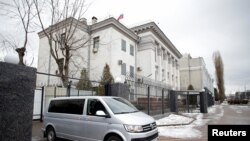On February 17 a channel called “Main News from Kyiv-44.ua” in the Russian messaging app Telegram posted a video of smoke rising from a building’s rooftop next to a Russian flag.
A male voice on the video noted that the smoke was from the Russian Embassy in Kyiv and that the only other time he had seen this was in 2014, when Russia moved against Ukraine’s Crimean Peninsula and Donbas.
Russia’s initial attack on Ukraine began in February 2014 when military personnel dressed in uniforms without insignias moved into Crimea. The subsequent war in Donbas has killed more than 14,000.
The Russian embassy video quickly spilled over onto other social platforms and went viral. Open-Source Intelligence (OSINT) social media accounts established the video’s authenticity.
British political analyst Kyle Orton said that the smoke means Moscow is preparing to evacuate its diplomatic staff from Kyiv amid predictions that Russia will launch a large-scale military invasion of Ukraine. According to the United States and other Western countries, some 150,000 troops are poised near Ukraine’s borders.
“The obvious explanation is that it is the burning of classified documents in advance of a withdrawal,” Orton tweeted.
Asked about the smoke, the Russian Embassy in Kyiv denied anything out of ordinary was happening. The embassy’s press attaché, Denis Golenko, told Russia’s state-owned RIA Novosti news agency:
“Work is proceeding on a regular schedule. Nothing extraordinary is happening here.”
That is false.
On February 10, Russia’s Foreign Minister Sergey Lavrov said that Moscow “likely will advise the non-essential personnel of our diplomatic offices (in Ukraine) to temporarily return home.”
Moscow has not commented officially about whether that process has begun. The Russian Foreign Ministry’s website was down on February 17, with a “technical error” page offering the ministry’s apologies for the inconvenience.
Yanking embassy workers home isn’t “regular” business.
Moreover, on February 17, Russia expelled the deputy chief of the U.S. diplomatic mission in Moscow, Bart Gorman, in what the U.S. State Department called an “unprovoked” and “escalatory step.” The Kremlin claimed Gorman was booted in response to the expulsion of a “minister” from Russia’s Embassy in Washington, D.C., but provided no details.
Russian presidential spokesman Dmitry Peskov reiterated on February 17 that the Kremlin has no intention of attacking Ukraine, contending that “it is the West that has been escalating the situation.” Russia announced it was withdrawing some of its estimated 150,000 troops amassed near Ukraine’s borders.
The U.S. and its NATO allies believe the Kremlin’s denials and the purported troop withdrawals are “a false flag operation,” and that Russia is prepared to move against Ukraine.
U.S. President Joe Biden said on February 17 that a “very high” probability remains that Russia will attack Ukraine in the next few days.
“They have not moved any of their troops out. They have moved more troops in,” he said. “We have reason to believe that they are engaged in a false flag operation, to have an excuse to go in. Every indication we have is they’re prepared to go into Ukraine and attack Ukraine.”
On February 17, the British Defense Ministry tweeted a map that “demonstrates President Putin's possible axis of invasion.”
“Russia retains a significant military presence that can conduct an invasion without further warning,” the ministry said.
The exact cause of the smoke apparently rising from the Russian Embassy in Kyiv remains unexplained. The embassy did not deny that there was smoke. Instead, official comments suggested the smoke was not caused by a fire or any other emergency.
Similar videos surfaced in 2017, when pillars of thick smoke were recorded rising from Russian embassies and consulates prior to their forced closure because of alleged Kremlin meddling in the 2016 U.S. presidential election.
At that time, the staff of Russian consulate in San Francisco turned away local firemen who responded to reports of a heavy smoke. The “people who came from inside the building” told the firefighters that “there was no problem, and that consulate staff were burning unidentified items in a fireplace,” The Associated Press reported in September 2017.
The San Francisco consulate was one of three Russian diplomatic missions that then-U.S. President Donald Trump ordered shut in retaliation for evidence of interference (in which U.S. intelligence assessments said were aimed at helping Trump win.) Previously, under President Barak Obama, the U.S. expelled some 35 Russian diplomats the White House said were undercover spies.
In retaliation for the 2017 closure of its diplomatic missions in the U.S., Russia ordered the expulsion of 755 U.S. diplomats.





